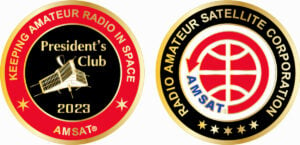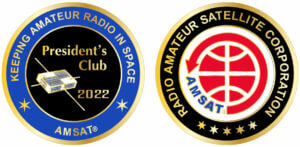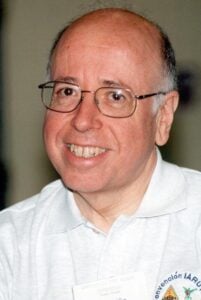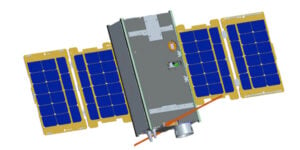In this edition:
* IARU Holds First 2023 Meeting
* AMSAT IT Tackles TLE Problem
* VK5QI Wins FS3 Award
* SpaceX Dragon Will Carry More Hams to ISS
* Balloon Experimenters Worry About Reactions
* Changes to AMSAT-NA TLE Distribution
* ARISS News
* Upcoming Satellite Operations
* Hamfests, Conventions, Maker Faires, and Other Events
* Satellite Shorts From All Over
The AMSAT News Service bulletins are a free, weekly news and information service of AMSAT, The Radio Amateur Satellite Corporation. ANS publishes news related to Amateur Radio in Space including reports on the activities of a worldwide group of Amateur Radio operators who share an active interest in designing, building, launching and communicating through analog and digital Amateur Radio satellites.
The news feed on http://www.amsat.org publishes news of Amateur Radio in Space as soon as our volunteers can post it.
Please send any amateur satellite news or reports to: ans-editor [at] amsat.org
You can sign up for free e-mail delivery of the AMSAT News Service Bulletins via the ANS List; to join this list see: https://mailman.amsat.org/postorius/lists/ans.amsat.org/
ANS-050 AMSAT News Service Weekly Bulletins
To: All RADIO AMATEURS
From: Radio Amateur Satellite Corporation
712 H Street NE, Suite 1653
Washington, DC 20002
DATE 2023 Feb 19
IARU Holds First 2023 Meeting
The 56th meeting of the Administrative Council of the International Amateur Radio Union (IARU) was held via Zoom on January 16, with President Tim Ellam, VE6SH, presiding.
The council received reports from the officers of each of the three regions. The meeting’s focus was on the International Telecommunication Union’s (ITU) upcoming World Radiocommunication Conference (WRC-23) later this year in Dubai, United Arab Emirates. The IARU effort for WRC-23 is being led by IARU Vice President Ole Garpestad, LA2RR.
Here is a summary of the meeting submitted by IARU Secretary Joel Harrison, W5ZN:
“Of particular interest to the amateur radio and amateur satellite services for WRC-23 is agenda item 9.1b concerning the amateur allocation in the 23 – centimeter band at 1240-1300 MHz. The Radio Navigation Satellite Service (RNSS) is seeking protection from secondary users in addition to an expanded allocation. Preparatory work for this item is being conducted within the ITU’s Working Party 5A. IARU’s global WRC-23 9.1b team, led by Barry Lewis, G4SJH, has been consulting with the amateur community, resulting in a contribution to the draft guidance recommendation in support of coexistence with RNSS. Details on this work can be found at www.iaru.org.
The council reviewed a comprehensive written report from IARU [Electromagnetic Compatibility] Coordinator Dr. Martin Sach, G8KDF, on his work with the International Special Committee on Radio Interference (CISPR). CISPR was formed in 1934 to set standards for controlling electromagnetic interference in electrical and electronic devices. CISPR’s specific areas include radio interference measurements and statical methods, and limits for the protection of radio frequencies.
An ongoing strategic planning review of the current IARU structure is being conducted within several Working Groups (WGs). The Administrative Council received reports from the Futures WG Steering Committee, Relationship WG, Governance WG, and the Legal WG. This work is scheduled for completion no later than July to allow discussion at the Region 1 [General] Conference in Serbia in October, with additional opportunities provided to the other two regions.
Region 1 has received several inquiries regarding the status of [John Devoldere’s,] ON4UN, and [Mark Demeuleneere’s,] ON4WW, book, Ethics and Operating Procedures for the Radio Amateur and is considering how this document [can] be updated.
The Summary Record from this meeting, in addition to previous meetings, is available at www.iaru.org/reference/ac-summary-records/.”
The next virtual meeting of the Administrative Council is scheduled for March 20, and an in-person meeting is scheduled for June 25 at the conclusion of Ham Radio in Friedrichshafen, Germany.
The members of the IARU Administrative Council are the President, Vice President, Secretary, and two members from each of the regional organizations. Members participating in this meeting were IARU President Tim Ellam, VE6SH/G4HUA; Vice President Ole Garpestad, LA2RR; Secretary Joel Harrison, W5ZN; IARUI Region 1; George Gorsline, VE3YV, President, and Rod Stafford, W6ROD,Sylvain Azarian, F4GKR, President, and Mats Espling, SM6EAN, Secretary, IARU Region 2; George Gorsline, VE3YV, President, and Rod Stafford, W6ROD, Secretary, and Region 3; Chairman Ken Yamamoto, JA1CJP, and Director Yudi Hasbi, YD1PRY. Assistant Secretary David Sumner, K1ZZ, also participated.
Founded in 1925, IARU is the worldwide voice of radio amateurs who secure and safeguard the amateur radio spectrum. ARRL serves as the International Secretariat of IARU.
[ANS thanks The ARRL Letter for the above information]
+=+=+=+=+=+=+=+=+=+=+=+=+=+=+=+=+=+=+=+=+=+=+=+=+=+=+=+=+=+=+=+=+=+=+
The 2023 AMSAT President’s Club coins are here now!

To commemorate the 40th anniversary of its launch
on June 16, 1983, this year’s coin features
an image of AMSAT-OSCAR 10.
Join the AMSAT President’s Club today and help
Keep Amateur Radio in Space!
https://www.amsat.org/join-the-amsat-presidents-club/
+=+=+=+=+=+=+=+=+=+=+=+=+=+=+=+=+=+=+=+=+=+=+=+=+=+=+=+=+=+=+=+=+=+=+
AMSAT IT Tackles TLE Problem
AMSAT IT, in conjunction with the New England Sci-Tech STEM Education Center assembled a tiger team of software experts from the Olin College of Engineering, Boston Latin School and the Wilson Middle School to investigate the recent disappearance of AO-7 from www.amsat.org/tle/current/dailytle.txt and the legacy naasbare.txt files.
The team determined that AMSAT’s processing is not robust in the face of minor format differences in the source data received from the USSF’s 18th Space Defense Squadron. Specifically, the TLE data provided does not always include the leading zero in AO-7’s object number “07530”. The official report from the team’s leader: “My grandma would say that AMSAT’s software is just a little too persnickety.”
A member of the tiger team agreed to adjust the update script to account for the vagaries of the 18th SDS data. A production quality fix is expected by March 1. Meanwhile, manual monitoring and updates will keep AO-7 in the files.
[ANS thanks Joe Fitzgerald, KM1P, AMSAT IT Team, for the above information]
+=+=+=+=+=+=+=+=+=+=+=+=+=+=+=+=+=+=+=+=+=+=+=+=+=+=+=+=+=+=+=+=+=+
Need new satellite antennas? Purchase Arrows, Alaskan Arrows,
and M2 LEO-Packs from the AMSAT Store. When you purchase through
AMSAT, a portion of the proceeds goes towards
Keeping Amateur Radio in Space.
https://amsat.org/product-category/hardware/
+=+=+=+=+=+=+=+=+=+=+=+=+=+=+=+=+=+=+=+=+=+=+=+=+=+=+=+=+=+=+=+=+=+
VK5QI Wins FS3 Award
The Mauritius Amateur Radio Society (MARS) announced, on January 19, a special Award for the last formal (AMSAT Leaderboard/Satnogs) reported signals from FalconSat3. An MO-112 postal first day cover was to be sent to the winner with the certificate.
On Janary 28, Mark Jessop, VK5QI, was declared to be the winner for the MARS FS3 Award. The certificate and MO-112 first day cover were sent last week in an envelope with MO-112 stamps.
Congratulations!
FS3 was a great adventure for many of us, thanks again to Mark (N8MH) for his dedication to keep the bird alive for so many years.
[ANS thanks Jean Marc Momple, 3B8DU, MARS President, for the above information]
SpaceX Dragon Will Carry More Hams to ISS
NASA will provide coverage of the upcoming prelaunch and launch activities for the agency’s SpaceX Crew-6 mission with astronauts to the International Space Station.
Launch is targeted for 07:07 UTC, Sunday, Feb. 26, from Launch Complex 39A at NASA’s Kennedy Space Center in Florida. The Dragon spacecraft is scheduled to dock to the space-facing port of the station’s Harmony module at 07:54 UTC, Monday, Feb. 27.
The Crew-6 launch will carry two NASA astronauts, Mission Commander Stephen Bowen, KI5BKB, and Pilot Warren “Woody” Hoburg, KB3HTZ, along with UAE (United Arab Emirates) astronaut Sultan Al Neyadi, KI5VTV, and Roscosmos cosmonaut Andrey Fedyaev, who will serve as mission specialists to the space station for a science expedition mission.
This is the sixth crew rotation mission with astronauts using the SpaceX Dragon spacecraft on a Falcon 9 rocket to the orbiting laboratory as part of the agency’s Commercial Crew Program. This Dragon is named Endeavour.
NASA TV launch coverage begins on Sunday, Feb. 26 at 03:30 UTC (10:30 p.m. EST).
[ANS thanks NASA for the above information]
Balloon Experimenters Worry About Reactions
Balloon hobbyists are also worried that the small balloons they launch into the sky could be shot down or that the focus on balloons could lead to tight restrictions on their little-known hobby.
Speculation has grown about whether one of the unidentified objects taken down by a U.S. F-22 on Feb. 11 over Canada’s Yukon Territory was a small party-style balloon launched by a hobby group whose name is a whimsical reference to the children’s film “Up.” The Northern Illinois Bottlecap Balloon Brigade recently said one of its balloons went “missing in action” on Feb. 11, near an island off the coast of Alaska.
People launch balloons for radio experiments, or as part of projects to learn more about technology, balloons, and the sky — as well as for fun, according to Dave Akerman, a member of the U.K. High Altitude Society who has launched nearly 100 larger latex balloons. Now enthusiasts are concerned “there will be a knee-jerk reaction to what’s happened,” he said in an interview.
He said he hoped that authorities and hobbyists could coordinate on reasonable guidelines or rules if needed. “It’s also in the interests of authorities not to be shooting down party balloons with missiles.”
[ANS thanks The Washington Post for the above information]
+=+=+=+=+=+=+=+=+=+=+=+=+=+=+=+=+=+=+=+=+=+=+=+=+=+=+=+=+=+=+=+=+=+
Want to fly the colors on your own grid expedition?
Get your AMSAT car flag and other neat stuff
from our Zazzle store!
25% of the purchase price of each product goes
towards Keeping Amateur Radio in Space
https://www.zazzle.com/amsat_gear
+=+=+=+=+=+=+=+=+=+=+=+=+=+=+=+=+=+=+=+=+=+=+=+=+=+=+=+=+=+=+=+=+=+
Changes to AMSAT-NA TLE Distribution for February 19
Two Line Elements or TLEs, often referred to as Keplerian elements or keps in the amateur community, are the inputs to the SGP4 standard mathematical model of spacecraft orbits used by most amateur tracking programs. Weekly updates are completely adequate for most amateur satellites. TLE bulletin files are updated Thursday evenings around 2300 UTC, or more frequently if new high interest satellites are launched. More information may be found at https://www.amsat.org/keplerian-elements-resources/
The following satellites have decayed from orbit and have been removed from this week’s AMSAT-NA TLE distribution:
CP-7 DAVE NORAD Cat ID 43615 (decayed from orbit on 02/12/23 per Space-Track).
NO-104 (PSAT-2) NORAD Cat ID 44354 (decayed from orbit on 02/15/23 per Space-Track).
[ANS thanks Ray Hoad, WA5QGD, AMSAT Orbital Elements Manager, for the above information]
———————————————————————
ARISS NEWS
Amateurs and others around the world may listen in on contacts between amateurs operating in schools and allowing students to interact with astronauts and cosmonauts aboard the International Space Station. The downlink frequency on which to listen is 145.800 MHz worldwide.
Completed:
Stella Maris College, Gzira, Malta, direct via 9H1MRL. The ISS callsign is presently scheduled to be OR4ISS. The scheduled crewmember is Josh Cassada, KI5CRH. Contact was successful: Wed 2023-02-15 12:48:01 UTC 60 degrees elevation. Congratulations to the Stella Maris College students and Josh for the first Malta contact!
Upcoming:
Istituto Statale di Istruzione Superiore “Il Pontormo”, Empoli, Italy, direct via IQ5EM. The ISS callsign is presently scheduled to be OR4ISS. The scheduled crewmember is Koichi Wakata, KI5TMN. Contact is go for: Thu 2023-02-23 09:32:56 UTC 60 degrees. Watch for Livestream at https://bit.ly/3I2xaKg
The latest information on the operation mode can be found at https://www.ariss.org/current-status-of-iss-stations.html
The latest list of frequencies in use can be found at https://www.ariss.org/contact-the-iss.html
[ANS thanks Charlie Sufana, AJ9N, one of the ARISS operation team mentors for the above information]
Upcoming Satellite Operations
From Richard, VA3VGR: Tentative plan, will depend on the roads and weather of course. All times UTC.
19 Feb – FN58
FO-29 18:41 145.950 Tx
FO-118 19:03 145.810 Tx
PO-101 19:17
CAS-3H 20:02
FO-29 20:23 145.950 Tx
19 Feb – FN57
RS-44 21:04 145.950 Tx
CAS-3H 21:34
FO-29 22:09 145.950 Tx
19 Feb – FN47
RS-44 22:53 145.950 Tx
JO-97 23:43 145.860 Rx
CAS-4B 00:05 145.925 Rx
CAS-4A 00:35 145.870 Rx
RS-44 00:47 145.950 Tx
20 Feb – FN38
RS-44 08:41 145.950 Tx (maybe – is there interest?)
FO-29 09:11 145.950 Tx
20 Feb – FN48
XW-2C 10:25 145.800 Rx
RS-44 10:34 145.950 Tx
FO-29 10:56 145.950 Tx
AO-91 12:06
AO-91 13:39
SO-50 14:01
JO-97 14:25 145.860 Rx
Also possible only if there is interest out west:
RS-44 12:28 145.950 Tx
FO-29 12:42 145.950 Tx
[ANS thanks Paul Overn, KE0PBR, AMSAT rover page manager, for the above information]
Hamfests, Conventions, Maker Faires, and Other Events
AMSAT Ambassadors provide presentations, demonstrate communicating through amateur satellites, and host information tables at club meetings, hamfests, conventions, maker faires, and other events.
+ 2023 CubeSat Developer’s Workshop
April 24-27, 2023
California Polytechnic State University
1 Grand Avenue, San Luis Obispo, California 93407
https://www.cubesatdw.org/
+ AMSAT Ambassador Clint Bradford, K6LCS, has a Zoom presentation scheduled with Thames Valley ARC, England on May 11, 2023.
[ANS thanks Paul Overn, KE0PBR, AMSAT Events page manager, for the above information]
Satellite Shorts From All Over
+ The Pehuensat-1 or PO-63, the hamradio payload made by Universidad del Comahue, Argentina that was attached to the structure of an Indian PSLV rocket, re-entered Earth atmosphere on January 16, 2023 according to Space_Track. (ANS thanks Gustavo Carpignano, LW2DTZ, for the above information)
+ As reported above, NO-104 (PSAT-2) decayed from orbit on 02/15/23. The Technical University of Brno in Brno, Czech Republic wishes to thank again Bob Bruninga WB4APR(SK) who allowed us to build the PSK transponder and to add the SSTV camera to the project undertaken by the U.S. Naval Academy. “We had lot of fun during experiments! Both transponder and camera operated flawlessly till the battery deterioration. Hopefully some future satelite builder will be interested in those space tested blocks.” (ANS thanks Tomáš Urbanec, OK2PNQ, of Technical University of Brno, for the above information.
+ A new Indian rocket successfully delivered three satellites to orbit on Thursday, Feb. 9, including Janus-1, which was built by the Indian-American company Antaris, is a technology-demonstrating “smart satellite,” according to the ISRO mission description. Like its predecessor, AzaadiSAT-2 was built by hundreds of female students from across India. AzaadiSAT-2 “aims to demonstrate LoRa and amateur radio communication capabilities, measure radiation levels in space and demonstrate expandable satellite structure, etc,” ISRO officials wrote. (ANS thanks Space.com for the above information)
+ Even as Russia’s Progress MS-22 arrived at the ISS, the uncrewed Progress MS-21 cargo craft lost pressure—this vehicle isn’t used for crew return and will be disposed of in a fiery reentry anyway, but it doesn’t increase confidence in aging ISS and Russian hardware—meanwhile, Russia is planning to launch a replacement for their other failing ISS vehicle, Soyuz MS-22, on Sunday, Feb. 19. (ANS thanks The Orbital Index for the above information)
+ As SpaceX tests a vehicle that will be capable of 100 tons to LEO (and, eventually, as much as 150 t), and continues a record-setting Falcon launch (and pad turnaround) cadence, the industry is talking about “bloodletting” and how other launch companies can’t compete with the $275,000 that SpaceX charges to take a 50 kg smallsat to Sun-Synchronoous Orbit (SSO) on a Transporter mission. (ANS thanks The Orbital Index for the above information)
Join AMSAT today at https://launch.amsat.org/
In addition to regular membership, AMSAT offers membership to:
* Societies (a recognized group, clubs or organization).
* Primary and secondary school students are eligible for membership at one-half the standard yearly rate.
* Post-secondary school students enrolled in at least half time status shall be eligible for the student rate for a maximum of 6 post-secondary years in this status.
* Memberships are available for annual and lifetime terms.
Contact info [at] amsat.org for additional membership information.
73 and remember to help Keep Amateur Radio in Space!
This week’s ANS Editor, Mark Johns, KØJM
k0jm [at] amsat.org



 XW-4(CAS-10) satellite adopts a 8U CubeSat structure with a mass of about 12kg, an on-orbit envelope size of 1007x790x475mm with four solar array panels and a three-axis stabilized attitude control system is used, long-term power consumption is about 18.3 Watts.
XW-4(CAS-10) satellite adopts a 8U CubeSat structure with a mass of about 12kg, an on-orbit envelope size of 1007x790x475mm with four solar array panels and a three-axis stabilized attitude control system is used, long-term power consumption is about 18.3 Watts.